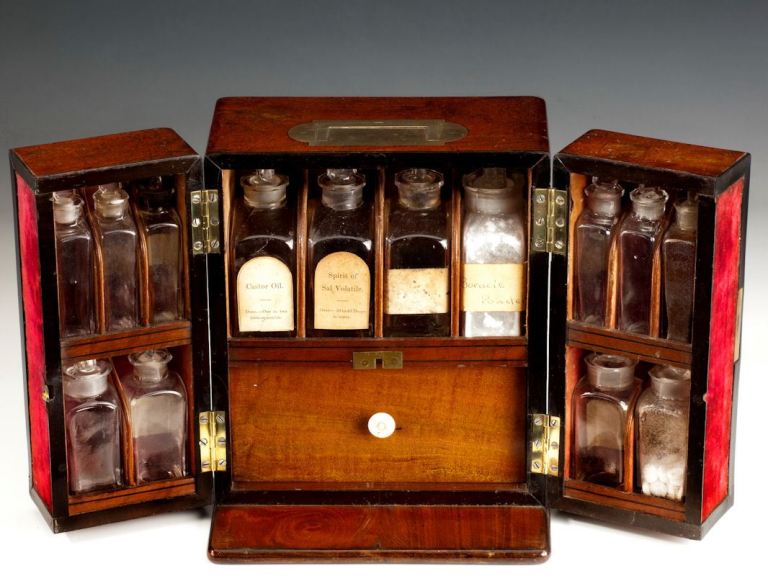|
By Tom Fournier My knowledge or interests do not naturally align with science or medicine but I could not resist this list of medical supplies that come from the Messages and Letters of William Henry Harrison; Volume 2 Part 2. Harrison was governor of the Indiana Territory and led the American military forces at the victories at Tippecanoe (1811) and Moraviantown (1813). He had command of Fort Meigs in Ohio in 1813. To my thinking, medical knowledge was at a strange crossroads at this time. Knowledge of anatomy had become quite advanced but the understanding of how it all worked still fell to a notion that the body had an ideal equilibrium and to solve for an illness or disruption meant restoring that equilibrium. Treatments such as bleeding, purging or blistering were still common. Equilibrium could be restored by releasing things like blood, urine, stool or perspiration. The body had four humours (blood, phlegm, yellow bile and black bile) and too much or too little of any of these humours would result in illness. Many items on this list of medical supplies seem to reflect this thinking. It was a challenge identifying some of these substances and determining their medical use during the early 19th Century. It is entirely possible that I have missed on some of these and we welcome corrections in the comments!
The quantities seem quite substantial but Fort Meigs was a staging area for a military force in the thousands. Medical Supplies Fort Meigs, June 30, 1813 50 lb. of Peruvian Bark (in powder) for use against malaria, fever and pain 50 lb. of Opium for use against pain 10 lb. of Camphor for use on skin as an antifungal, antibacterial 5 lb. of Calomel for use as a purgative and a fungicide 2 lb. of Corrosive Sublimate (Mercury Sublimate) for treatment of Syphilis 2 lb. of Tartar Emetic to be used as an expectorant (helps clear phlegm from the lungs) 2 lb. of Gambage a resin that acts as an emetic (causes vomiting) and cathartic (accelerates defecation) 10 lb. of Jalap a cathartic 17 lb. of Ipecauanto (Ipecacuanha) an emetic 10 lb. of Rheubard (in powder) a cathartic and a laxative 15 lb. of Kino used as an astringent (constriction or contraction of mucous membranes, also stops mucous secretions. On skin can reduce oily skin and irritations). 20 lb. of Colombo (in powder) which is useful with bilious diseases, diarrhea and vomiting. 20 lb. of Nitre Crude (Saltpeter) used as a diuretic, sedative and antiseptic 40 lb. of Nitre Sweet Spirits used as a diaphoretic (causes sweating), diuretic and an antispasmodic 50 lb. of Glaubers Salts used as a laxative 20 lb. of Prepared Chalk used as an astringent and an antacid 12 gallons of Caster Oil used as a laxative 5 gallons of Olive Oil used as a laxative, an ingredient in creating adhesive plasters and a skin coating under bandages 20 lb. of Gum Arabic used for coughs, sore throats, diarrhea and dysentery 5 lb. of Allume (Alum) used as an astringent 20 lb. of Acquous (difficult to determine, there are many acquous or acqueous extracts from various substances) 20 lb. Adhesive plaster used as sticky bandages created by a mixture of olive oil, resin and lard on muslin 2 barrels of Barley for use with indigestion, inflamed bowels or diarrhea 300 lb. of Chocolate often used in drink to stimulate feeble patients and calm overstimulated patients 50 lb. of Tapioca (Cassava) used for treatment of flu, diarrhea and inflammations 20 lb. of Blisting Ointment used to deliberately raise blisters as part of medical treatment 20 lb. of Bees Wax used in the creation of an ointment used to seal wounds and then covered with a cloth dressing 4 lb. of Muriated Acid (Hydrochloric Acid) used as a cure for fever 4 lb. of Sulphuric Acid (Oil of Vitriol) used for disinfecting and sanitizing water 4 lb. of Nitric Acid used for a treatment of warts and cankers and in a diluted form for dyspepsia (indigestion or bloating) 200 gallons of Wine used for disinfecting and as a base for mixed medicines 100 gallons of Brandy or Rum used as a cardiac stimulant and an anesthetic 200 gallons of Vinegar used to prevent headaches, infections and masking bad odours 200 gallons of Molasses used as a nutrient and an anti-inflammatory 300 lb. of Coffee used as a metabolism stimulant 50 lb. of Hyson Tea used as a metabolism stimulant 5 barrels of Rice used in rice water for rehydration from diarrhea and dysentery 6 barrels of Sugar used as a treatment for ailments and fever 50 lb. of Sago (Palm Starch) used as a thickening agent, also though to cool the body 5 gross of Vials 3 setts of Amputation 3 setts of Trepanning 3 setts of Pocket No. 6 - Cases Scalpels 3 dozen Lancets 12 setts of Splints 7 lb. of Sponge 1000 yards of Muslin
4 Comments
Peter Monahan
6/10/2019 08:47:49 am
Fascinating! Thanks for doing this research. One question: any evidence from the documents that the rum was in fact used as an anesthetic, or is that an inference?
Reply
Tom
6/28/2019 12:14:39 pm
Hi Peter, no evidence, just what I pulled from poking around the web trying to identify the items and their possible uses. As i cautioned in the article, I am a non science and non medicine guy!
Reply
simon Love
6/16/2019 09:58:18 am
Alcohol was not used before or during an operation as it was known to be a diuretic and cause greater blood and fluid loss by the thinning of the blood. It was often administered post operation as a sedative.
Reply
Tom
6/28/2019 12:15:40 pm
Thanks for the clarification!
Reply
Your comment will be posted after it is approved.
Leave a Reply. |
AuthorsThese articles are written and compiled by members of the 41st Regiment Living History Group. Archives
January 2023
Categories |
